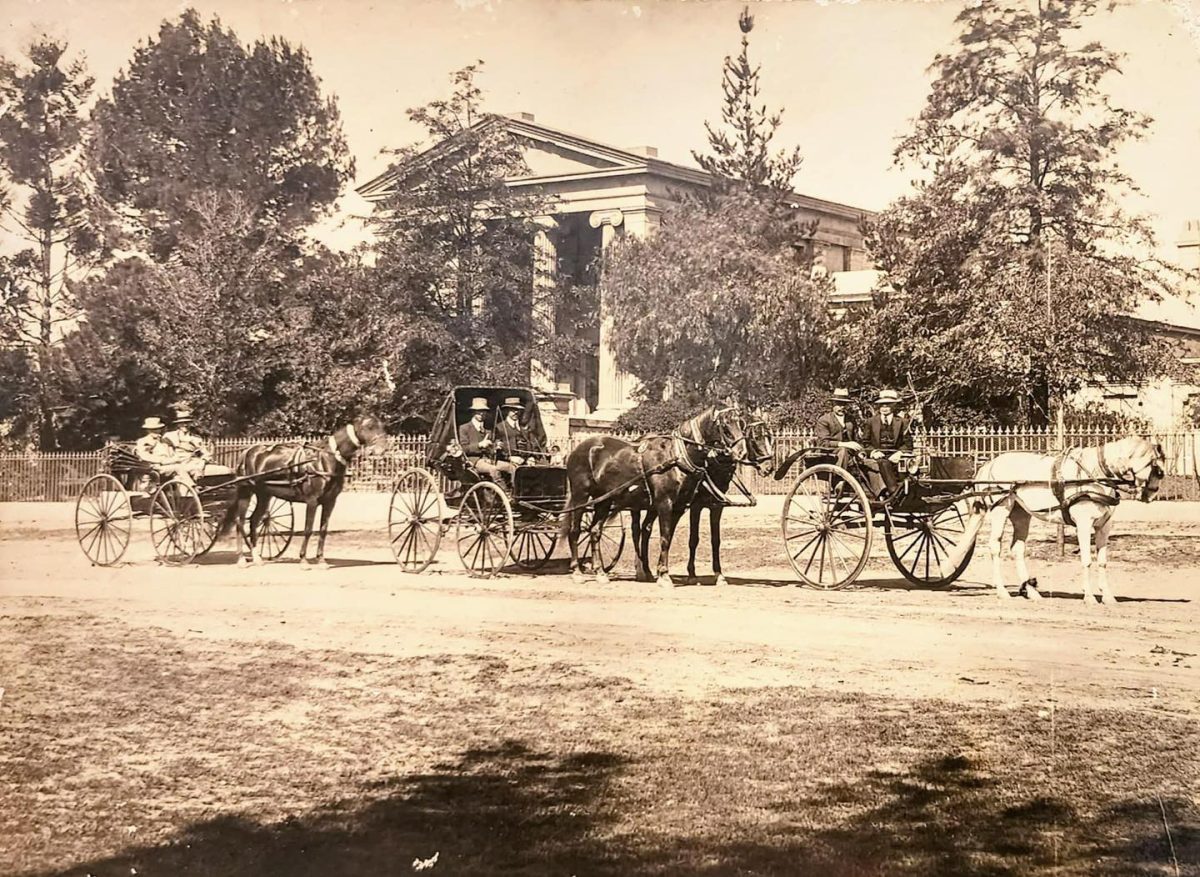
Young’s iconic old courthouse sits in the background of this photo showing carriages in Carrington Park. This year marks the 100th since the courthouse was officially reopened as Young High School. Photo: Young High School Facebook.
For a century, a grand Greek-inspired sandstone courthouse overlooking Carrington Park in Young has stood as a silent witness to justice, transformation and, ultimately, generations of learning.
What was once a place of solemn legal proceedings became, on 29 April 1925, a home for education — an institution that would shape the futures of thousands of students.
Now, 100 years later, Young High School is celebrating this remarkable milestone with a series of events in the town tagged “A Century of Learning: Young High School’s 100-Year Celebration” that honor the school’s history, its students and the stunning building that has stood as its foundation.
The first of these was held on 7 April in the form of a small ceremony at the school, which threw open the gates to dignitaries for an official centenary ceremony and tour before welcoming the broader community for an afternoon viewing of the school campus.
The Young Historical Museum will be marking the occasion in May, as part of the National Trust’s Australian Heritage Festival, with an exhibition showcasing the evolution of schooling in Young and the surrounding district.
Before it became a place of learning, the building housing Young High School was an architectural marvel designed by James Barnet, one of Australia’s most distinguished colonial architects, who, so impressed by the substantial character of the town and its commercial importances, undertook to recommend, “the erection of a building worthy of the district” as an alternative to the rather forlorn old timber courthouse that stood in the centre of town.
Completed in 1886 by Gough and Co of Young at a cost of 12,000 pounds – thanks to a paved way laid by the Colonial Treasurer at the time, James Watson MLC, who had, with his brothers, established businesses in the town during the gold rush – the Young Courthouse, complete with portico reached by 14 stone steps and adorned with eight Ionic columns, stood as an imposing structure, its High Victorian Classical style reflecting the grandeur and authority of the legal system it once served.
Inside – and equally imposing – the courtroom was preceded by a vestibule bookmarked by two winding staircases leading to a public gallery from which the entire 18 x 10 x 8 metre round cornered room softly lit by 14 lofty windows glistened with polished cedar fittings. The building would include eight rooms to accommodate a judge, attorney general, Crown solicitor and male witnesses, barristers, sheriffs and juries and, at the rear, a five-room caretaker’s residence.
Judge Bevan, presiding over cases there in the early 1920s, remarked on the building’s grandeur and lamented its underutilisation. At the time, the courthouse was used only four times a year for Quarter Sessions.
In 1923, he would be the first to suggest it be turned into a high school: “It is so much waste to have this building idle for most of the year when it could be put to such a good use.”
The Department of Justice initially rejected this proposal. However, the wheels of justice turned swiftly, with persistent lobbying from the community and a commitment from the Department of Education to restore another courthouse in Young, which had fallen into disrepair, the building was finally repurposed for education.
Officially opened in 1925 by Mr Bruntnell, minister for education, the old courtroom formed the nucleus of the new school serving, according to newspaper reports as a “spacious dignified assembly hall”.
It was a proud time. Keith McIntosh, a student at that time among the throng who subsequently spilled out of the overcrowded Young Public School across Campbell Street to the new digs was quoted as saying, “All the students are very proud of having this fine school to study in, as it is said to be the finest in the state.”
Over the years, the courthouse-turned-school saw many developments, including the construction of new classrooms in 1936 and the transformation of old gaol buildings into modern technical training rooms in 1941.
The Young Intermediate High School grew alongside the town’s evolving education system. Initially an intermediate high school, it officially became Young High School in 1946 due to increasing enrolments.
Throughout the years, students actively contributed to the community, supplying Young District Hospital with hundreds of eggs in the 1930s and fundraising for the Red Cross during World War II.
Many Young High School graduates have gone on to achieve remarkable success in various fields, earning a place on the school’s “Wall of Renown”. Among them is Brett Mullins (class of 1990), who became a star rugby league player for the Canberra Raiders.
Other notable alumni include The Most Revd. Dr Peter Carnley, who served as the Anglican Archbishop of Perth, and Jan Staal, who became a distinguished aircraft maintenance engineer for QANTAS before joining the RAAF.
The tradition of excellence continues with recent honorees such as Kate Schiller, who became the first Australian woman to win the British Open in clay target shooting, and Dr Leigh Ellis, a leading cancer researcher who has worked at institutions such as the Sidney Kimmel Comprehensive Cancer Center at Johns Hopkins.
The Young Historical Museum will hold its special event on Saturday May 3.
Visitors to that exhibition will find an extensive collection of class photographs dating from the 1920s to today, a display of former school uniforms and student magazines highlighting extracurricular achievements such as sports and arts. Examples of student work over the decades will also be on show.
To deepen the historical connection, Young High School and Young Historical Museum are inviting visitors to help identify former students and teachers in a selection of historical photographs.
The day’s festivities will include a barbecue hosted by the Lions Club, a DJ playing Australian folk music, and a variety of activities to engage alumni and community members alike.
For those wishing to learn more, further details about the celebrations can be found on the Young High School website and Facebook page, while information on the Young Historical Museum event can be found on the National Trust website.







